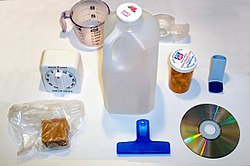This article includes a list of general references, but it lacks sufficient corresponding inline citations .(May 2022) |
Extrusion coating is the coating of a molten web of synthetic resin onto a substrate material. It is a versatile coating technique used for the economic application of various plastics, notably polyethylene, onto paperboard, corrugated fiberboard, paper, aluminium foils, cellulose, non-wovens, or plastic films. It was first developed in the 1940s for polyethylene coated paper for bags and packaging. [1]

